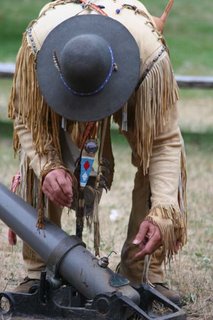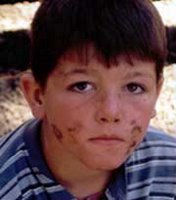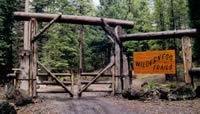Sunday, July 30, 2006
Saturday, July 29, 2006
Steve Hopkins Message to Artists and Writers - Part VIII
Today, Steve is continuing on the idea of using our gifts. Point One cautioned us to be patient but persistent with our pastors. A lot of folks have given me suggestions and I will be sharing those at the end of the entire series.
********
I like impressionism but what I can really use in a worship setting is something that holds, or translates a theological truth or illustrates creatively a scene in the life of Jesus.
I don’t know if you’ve seen any of the Masterpeace collection by Ron Dicianni, Michael Dudash, Thomas Blackshear, and my brother, Chris Hopkins. They each depict a scene of an historical Jesus in some biblical context, but there is also a current day person in the picture. I think that’s great.
As a pastor concerned with a worship service, I am careful to make sure everything is directed around the person and the presence of Christ.
I am more concerned that people come in contact with Him than I am at giving useful but sterile principles on how to live. I think of Adam and Eve—their experience with God was relational—and that’s my focus. And I am looking for tools that will help me accomplish that goal.
I will sometimes call upon an artist to paint the section of scripture I am teaching from. I taught Nehemiah 8, and a woman in the congregation painted a wonderful picture. She started it at home and finished it during the service. Now, it’s hanging in our coffeeshop and every time we see it we are reminded of the message of Nehemiah 8. That’s great!
In the near future I plan to have a huge canvass behind me, about ten feet or so. And I am going to have three or four artists painting at the same time.
Now, I as a pastor need to know in advance what the theme of a message is going to be, and then work with the artists and give them some time to come up with an idea…and sometimes pastors don’t have their theme before 5:00 a.m. on Sunday morning (sometimes me too!). But when I know what I am going to teach, I will sometimes draw upon an artist to help me communicate some truth of my message, especially if it’s a difficult concept.
********
Wow! What a fascinating concept of using art to bring home a biblical concept. At the recent artists retreat at Box R Ranch, Jeanne Randall challenged us to come up with a biblical painting around the theme of, “Let There Be Light.” Then we can bring our paintings to be juried into next years show.
I’ve only done this once when I was asked to do a painting of the triumphal entry for a passion show. What agony! What joy! I had to do research. Find out what kind of crowd would have showed up to welcome Jesus. I also had to search through my photos taken in Jerusalem and the surrounding area, coming up with a landscape and people in various styles of dress and adoration.
The completed painting depicts much joy, which is exactly what I think the original day was full of—pure, unadulterated joy at welcoming The King.
I admit that it’s easier to pick my own subjects and paint whatever I feel like, but accepting and accomplishing that challenge made me feel very fulfilled.
Chris Hopkins actually uses people he knows to pose for subjects in his paintings. One painting he did of Christ calming the angry seas shows a boat full of Chris’ family and friends. His brother, Steve, likes to point out that his very own hand is what Chris used for the hand of Christ. Ha!
So, now I’m thinking…what pictures could I paint that would bring home a message more clearly? And I’m surprised at how many ideas I’ve come up with. The first I plan to do is for a show called, “Reflections,” where we depict some way that God’s love is reflected in our world.
What ideas can you come up with? Why not give yourself a challenge and start on one today?
Enjoy the Son!
Friday, July 21, 2006
Steve Hopkins Message to Artists and Writers - Part VII
Today, we start the second in the messages given by Pastor Steve Hopkins at the awesome art retreat at Box R Ranch in May. Now, we are entering the using of our gifts.
The photos are images I took at the Tall Trees Rendezvous earlier this month.
*******
A pastor notices a new family visiting his church. After the service, he introduces himself and strikes up a conversation with the visitors. The husband says that they have just moved to the area and they are looking for a church where they can be actively involved in ministry.
Unable to contain his excitement, the pastor asks, “Where would you like to be involved?”
The husband responds, “My wife and daughter dance, my son is a painter, and I am a playwright.”
There is a deathly silence for what seems like a week.
Then the pastor says, “Well, the choir is always looking for more singers and maybe your wife and daughter can act out a skit you write for our children’s ministry, but dancing may take a review and decision by the Board.”
This is a true story, because the pastor in this story is me, before I felt the freedom and desire to use more artistic means to communicate biblical truths.
I have since learned that art and dance can come closer than systematic theology at capturing and allowing us to experience the mystery of God.
Mel Gibson proved that drama can more adequately demonstrate the agony of Christ.
And a picture can illustrate better than words abstract theological truths like the trinity or the Incarnation…Or the Humanity of Christ over and against His deity.
The arts exercises the mind to understand the many levels of meaning in Scripture.
Augustine and Aquinas both felt that God purposely made the Bible difficult so that we would have to wrestle with it (Bible is not stream-lined, not all slick packaging).
But most ministries and pastors are reluctant to use the arts in worship, mostly because they don’t know how to use it or are afraid of being connected with the Emergent Church, which they haven’t decided yet if it’s good or bad. But the fact is we have moved from a telegraphic society to a televisual society.
So, the question I want to explore is…How can artists find their niche within the Covenant community? And how can leadership provide a nurturing environment for artists?
First off, I think the pendulum is swinging back toward art in the church. In the early days of Christianity, and even after the Bible was mass produced, the masses were illiterate and much of our theology was communicated and preserved in art.
I have a very gifted artist and historian in our church, and as part of the worship service, she will present a piece on screen and will tell us a little about the author, when it was painted, and the subject matter. She then will make a present-day connection to the theological truth or scene we see on the canvas.
A few weeks ago, she had a piece by Cavaggio that was dynamic. She presented the piece picturing Mary and Martha and talked in three minutes of her struggle of always being a Martha. It was very affective.
I was at the Hermitage this last summer and saw a piece by 17th Century Spanish artist Murrillo called, “The Prodigal.”
We don’t use icons in my church, but we flash the words to our worship songs on the screen and behind them is a Masterpiece painting or a classical piece. We call it visual praise.
So, things are changing.
The high churches are incorporating art in their worship services, but more of the staunch churches like Calvary Chapel are being freed up to use more art and videos in worship services. It’s funny, cause they call me and I feel like they are like little kids who just found the key to their parent’s liquor cabinet.
So how can you as an artist help assist us pastor types in using art in ministry?
Speaking as a pastor, here are some things that may help you integrate art in your church.
1. Be patient, but persistent.
One of the problems the Church and we pastors have with the arts is one of perception. We tend to look upon the arts in a different way from other vocations. How many times have you heard, “Oh, you’re the artist. So, what do you do for a living?”
The idea that an artist can make a living with his craft is foreign to many. Which I find ironic, because many see us pastor types as working only a few hours one day a week and they wonder how we support ourselves. Ha!
And honestly, this attitude has hurt the arts in the church. Vincent Van Gogh trained for the Dutch Reformed pastorate. He found early on that he just was not “pastor material.” He wanted to serve Christ with his gifts, but the church had no place for him and would not accept him with his artistic idiosyncrasies. Instead of accepting, discipling, and nurturing him, they just branded him as strange and cast him aside.
This was a sad thing, because the Church lost a great opportunity by her own callousness.
But again, I think the pendulum swing is shifting, and as it is shifting you can help us pastor types by being patient and dialoguing and teaching us how art can be used in a worship service, or in the church. Be patient, but persistent with your pastor.
*******
Okay, we’ll stop there today.
At the art conference, we spent some time thinking of ways we can use our art in our local churches. And I’m very interested in ways other artists are using their art in their churches. So, please leave a comment or send and e-mail. Perhaps we can help one another come up with some new ways of ministry!
Recently, one of my fellow artists came up with the idea for us artists to be painting abstract visuals at a Friday night jazz concert at our church. Now, that’s a fresh idea. And another church in town is holding a Christian artist’s contest at their annual women’s luncheon. I’m even planning to take part in that.
There’s a world of opportunities out there. What ideas do you have?
Monday, July 17, 2006
Putting Down the Giants—Part VI

Here is the conclusion of the first message given by Steve Hopkins at the recent art conference at Box R Ranch. In a couple of days we will begin the second message.
Are you a writer?
Were you put on this earth to be a painter? A poet? A songwriter? A musician?
Only you can answer that question.
But if you are, consider this:
In the movie, “Field of Dreams,” Kevin Costner goes back in time to the seventies to find an old doctor played by Bert Lancaster named Dr. Graham who played one inning in the minor leagues. But Dr. Graham gave up his dream of being a professional baseball player to become a physician in the small ordinary town of Chisholm. Minnesota. He fantasized what it would have been like to hit a single and stare down a sky so blue that you had to squint to see the ball.
Kostner said, “What a tragedy you never got to fulfill your dream.”
But Doc Graham said something very profound. He said, “If I had not become a doctor, that would have been a tragedy.”
If you were put on this earth with the ability to cure cancer, or write a book, or crack cold fusion and you don’t do it, that will be a tragedy.
You not only hurt yourself, but you hurt and deprive everyone of your gift. And worst of all, you shame our Lord who gave you that gift.
Artists and writers are a gift to the world.
Don’t cheat us of your contribution.
Beat the giant (resistance, procrastination, and fear) and give us what you’ve got.
*****
Are you ready for Steve’s challenge?
Or does fear and procrastination stop you. If you need to, go back over the other posts of Steve’s message and begin taking steps to defeat that ugly ole giant. We’re not on our own in doing this. God has given us the power through His Spirit to overcome the giants of the land if we are willing to take advantage of it.
I’m making steps in doing just that. I’m beating down procrastination by actually putting words on computer one word at a time. Sometimes it like pulling them out one at a time, but if I stick at it, before long I have something of significance. And you can too, one word after another….
Enjoy the Son!
Wednesday, July 12, 2006
I'm Back!

Wow! It was a long couple of weeks. The Rendezvous was absolutely wonderful. It’s awesome to take time to slow down and live life in a more creative way.
Trapper John is the leader of the Tall Trees Rendezvous at Smith River, California. He seems to fit better there than anywhere else. He sleeps in a primitive tent and fires up a forge to make pot hookers the old-fashioned way. He can make a fire with flint and steel in less than thirty seconds.  “Used to be anyone could do it,” Trapper says. “That’s one of the reasons it’s good to have the rendezvous. It’s a learning experience. We’ve lost things in history that will never be found until we try to recreate it, hoping to find a piece of history that was lost.”
“Used to be anyone could do it,” Trapper says. “That’s one of the reasons it’s good to have the rendezvous. It’s a learning experience. We’ve lost things in history that will never be found until we try to recreate it, hoping to find a piece of history that was lost.”
I agree with Trapper John. There is a lot of history that was lost that we would do well to find again. It’s easy to see at a rendezvous where families enjoy spending time together instead of hiding away behind walls that keep out every semblance of wild or community. Sometimes living for a week the old way is uncomfortable or messy, but it’s nice to know that if you had to do it the hard way, you could.
Speaking of the hard way. The Cat Man and I lived for seven years in a home that had no electricity or running water. We had to hike a half mile up hill to reach it. Now, that’s messy! But, oh, was it wonderful. What adventures we had.
Another thing about the rendezvous is that we spend a lot of time making things to use and wear while we’re there. It’s satisfying to make something from the ground up, because nowadays everything is done for you. It’s also satisfying to spend time working on something and being able to show it off to someone else who understands what went into the making of it.
That’s one thing the internet is good for as well. We can share our creations with others who understand the creating process. It means a lot to me when someone leaves a comment or sends an e-mail in response to specific piece of writing, photo, or art.
The Rendezvous also makes me aware of being a part of history, of taking a place inside a story that began a long time ago. It started with the first settlers and continues through the stories I place on paper or computer one word at a time so the next generation won’t forget what’s gone before and will be thankful for coyote song and tall timber.
Thanks for your patience as I’ve taken a break from the internet in order to recapture beauty and simplicity. I’ll be sharing photos of the rendezvous along with the rest of Pastor Steve Hopkins’ message to artists and writers over the next couple of weeks.
Enjoy the Son!










